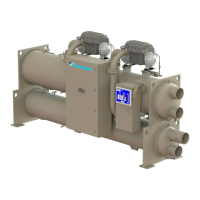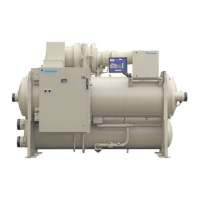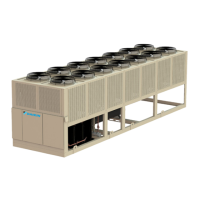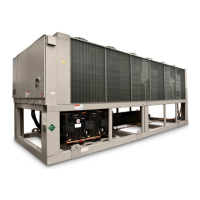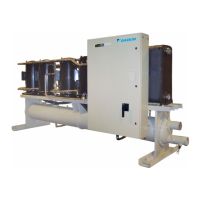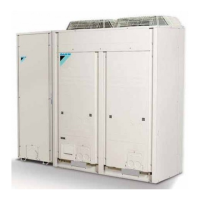35
IOM 1264-4
WWW.DAIKINAPPLIED.COM
OPERATION
Position set point.
In this mode the valve position is calculated by a PID loop to
control the condenser EWT or LWT (as selected by the Tower
Control set point) to the active set point. The active set point is
selected based on the fan stage as shown below:
Tower Fan
Stage
Active Set Point
0 Valve/VFD Set Point
1 Tower Fan Stage 1 On Temperature
2 Tower Fan Stage 2 On Temperature
Cooling Tower Fan VFD
When the Valve/VFD Control set point is set to None, Valve
Setpoint, or Valve Stage, cooling tower fan VFD control should
not be operational and the speed should always be set to 0%.
If the Valve/VFD Control Conguration set point is set to VFD
Stage or Valve SP/VFD Stage then VFD speed will be controlled
as described below.
When active a VFD speed is calculated and limited to a range
dened by the VFD Minimum Speed set point and the VFD
Maximum Speed set point.
The VFD speed should always be 0% when the fan stage is 0.
When one or both fan stages are on, the VFD speed should be
calculated using a PID loop to control the condenser EWT or
LWT (as selected by the Tower Control set point) to the active set
point. The active set point is selected based on the fan stage as
shown below.
Tower Fan
Stage
Active Set Point
0 N/A
1 Tower Fan Stage 1 On Temperature
2 Tower Fan Stage 2 On Temperature
As the calculated speed varies from 0 to 100%, the voltage signal
for the Tower VFD Speed output should vary from 0 to 10 VDC.
Leaving Water Temp (LWT) Target
The LWT Target varies based on settings and inputs. The base
LWT Target is selected as shown inTable 29.
Table 29: LWT Targets Control Source
Available
Modes Set
Point
Control
Source
Set Point
Mode
Input
BAS
Re-
quest
Base LWT Target
COOL
Local - - Cool Set Point
Network - - BAS Cool Set Point
Cool/Ice
Local
O - Cool Set Point
On - Ice Set Point
Network
- Cool BAS Cool Set Point
- Ice BAS Ice Set Point
Ice
Local - - Ice Set Point
Network - - BAS Ice Set Point
LWT Reset
The base LWT target may be reset to a higher value if the unit is
in Cool mode and LWT Reset Enable is enabled.
When the reset is active, it will be 0 if the reset signal is less than
or equal to 4 mA. Reset is equal to the Max Reset set point if
the reset signal equals or exceeds 20 mA. The amount of reset
will vary linearly between these extremes if the reset signal is
between 4 mA and 20 mA.
Figure 22: 4-20mA Reset
When the active reset increases, the Active LWT Target is
changed at a rate of 0.1 °C (0.18 °F) every 10 seconds. When
the active reset decreases, the Active LWT Target is changed all
at once.
After reset is applied, the LWT target can never exceed a value of
20.0°C (68°F). Since the Cool LWT set point can be set as high
as 20.0°C, the amount of reset may be limited in order to meet
this requirement to clamp the active LWT target to 20.0°C.
Unit Capacity Control
Unit capacity control will be performed as described in this
section. Loading and unloading the refrigerant circuit is used to
control the overall unit capacity.
Cool Mode Operation
LWT error and EWT pulldown rate are the primary factors in unit
capacity adjustments. This section details all the logic for unit
capacity control in Cool Mode.
Staging On
Unit capacity control will command the circuit to start if all of the
following are true:
• Unit State = Auto
• Evaporator Pump State = Run
• LWT error > Startup Delta T set point
Staging O
Unit capacity control logic will command the circuit to shut down if
either of the following conditions are true:
• LWT error < -(Shut Down Delta T set point)
• LWT < LWT Target AND EWT < LWT Target
Max Reset
Base LWT
Target + Max
Reset
Base LWT
Target
200
Reset Signal (mA)
Active
LWT
Target
4
4
20 mA Reset
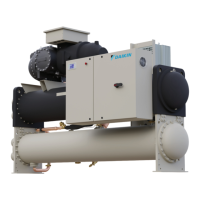
